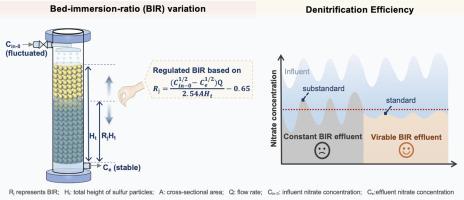Bed-immersion-ratio variation as an efficient strategy to regulate denitrification efficiency directionally in elemental sulfur packed-bed reactors
IF 11.4
1区 环境科学与生态学
Q1 ENGINEERING, ENVIRONMENTAL
引用次数: 0
Abstract
Autotrophic denitrification in sulfur packed-bed reactors (S0PBR) has been widely employed for treating municipal secondary effluent. However, the fixed volume of packed sulfur in S0PBR restricts the ability to adjust denitrification efficiency in response to fluctuating influent nitrate levels, leading to either effluent standard exceedances or unnecessary sulfur consumption. Here, we proposed a novel method for directionally regulating nitrate removal efficiency (NRE) in S0PBR by adjusting the bed-immersion-ratio (BIR). The results demonstrated that the NRE could be effectively controlled through adjustments of BIR, with the maximum NRE achieved when BIR was increased to 1.00. Notably, a non-zero minimum NRE was observed when BIR decreased to 0.00. This could be associated with actual hydraulic retention time (aHRT), with a strong correlation observed between aHRT and BIR. Based on these findings, a kinetic model was developed that integrated both exposure and immersion parts, expressed as . This model proved effective for describing the nitrate reduction kinetics in the S0PBR under BIR variation. The effluent concentration achieved a more stable designed nitrate level under BIR variation guided by our developed model, compared to the effluent nitrate concentration under full immersion. Besides, sulfur consumption could be reduced by 7.8 % to 31.6 % under BIR variation due to the reduced nitrate removal. Overall, this study proposed a novel approach for achieving stable nitrate effluent guided by our developed model under fluctuating influent nitrate loadings, which was both efficient and economical.


变化床层浸没比是单质硫填料床反应器中定向调节脱氮效率的有效策略
硫填料床反应器(S0PBR)自养反硝化技术已被广泛应用于城市二级污水的处理。然而,S0PBR中固定体积的填料硫限制了根据进水硝酸盐水平的波动调整反硝化效率的能力,导致出水标准超标或不必要的硫消耗。本文提出了一种通过调节床层浸没比(BIR)来定向调节S0PBR中硝酸盐去除效率(NRE)的新方法。结果表明,通过调整BIR可以有效地控制NRE,当BIR增加到1.00时,NRE达到最大值。值得注意的是,当BIR降至0.00时,观察到非零最小NRE。这可能与实际水力滞留时间(aHRT)有关,aHRT与BIR之间存在很强的相关性。在此基础上,建立了一个包含暴露和浸泡两部分的动力学模型,Rj=(Cin - 01/2−Ce1/2)Q2.54AHt−0.65Rj=(Cin - 01/2−Ce1/2)Q2.54AHt−0.65。该模型可以很好地描述BIR变化下S0PBR中硝酸盐的还原动力学。在该模型指导下,在BIR变化条件下,与全浸条件下相比,出水硝酸盐浓度达到了更稳定的设计硝酸盐水平。在BIR变化条件下,硝态氮的去除率降低,硫耗可降低7.8% ~ 31.6%。总的来说,本研究提出了一种新的方法,在我们开发的模型的指导下,在波动的进水硝酸盐负荷下实现稳定的硝酸盐流出,这是既有效又经济的。
本文章由计算机程序翻译,如有差异,请以英文原文为准。
求助全文
约1分钟内获得全文
求助全文
来源期刊

Water Research
环境科学-工程:环境
CiteScore
20.80
自引率
9.40%
发文量
1307
审稿时长
38 days
期刊介绍:
Water Research, along with its open access companion journal Water Research X, serves as a platform for publishing original research papers covering various aspects of the science and technology related to the anthropogenic water cycle, water quality, and its management worldwide. The audience targeted by the journal comprises biologists, chemical engineers, chemists, civil engineers, environmental engineers, limnologists, and microbiologists. The scope of the journal include:
•Treatment processes for water and wastewaters (municipal, agricultural, industrial, and on-site treatment), including resource recovery and residuals management;
•Urban hydrology including sewer systems, stormwater management, and green infrastructure;
•Drinking water treatment and distribution;
•Potable and non-potable water reuse;
•Sanitation, public health, and risk assessment;
•Anaerobic digestion, solid and hazardous waste management, including source characterization and the effects and control of leachates and gaseous emissions;
•Contaminants (chemical, microbial, anthropogenic particles such as nanoparticles or microplastics) and related water quality sensing, monitoring, fate, and assessment;
•Anthropogenic impacts on inland, tidal, coastal and urban waters, focusing on surface and ground waters, and point and non-point sources of pollution;
•Environmental restoration, linked to surface water, groundwater and groundwater remediation;
•Analysis of the interfaces between sediments and water, and between water and atmosphere, focusing specifically on anthropogenic impacts;
•Mathematical modelling, systems analysis, machine learning, and beneficial use of big data related to the anthropogenic water cycle;
•Socio-economic, policy, and regulations studies.
 求助内容:
求助内容: 应助结果提醒方式:
应助结果提醒方式:


